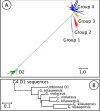A phylogenetically novel cyanobacterium most closely related to Gloeobacter
- PMID: 32424249
- PMCID: PMC7368068
- DOI: 10.1038/s41396-020-0668-5
A phylogenetically novel cyanobacterium most closely related to Gloeobacter
Abstract
Clues to the evolutionary steps producing innovations in oxygenic photosynthesis may be preserved in the genomes of organisms phylogenetically placed between non-photosynthetic Vampirovibrionia (formerly Melainabacteria) and the thylakoid-containing Cyanobacteria. However, only two species with published genomes are known to occupy this phylogenetic space, both within the genus Gloeobacter. Here, we describe nearly complete, metagenome-assembled genomes (MAGs) of an uncultured organism phylogenetically placed near Gloeobacter, for which we propose the name Candidatus Aurora vandensis {Au'ro.ra. L. fem. n. aurora, the goddess of the dawn in Roman mythology; van.de'nsis. N.L. fem. adj. vandensis of Lake Vanda, Antarctica}. The MAG of A. vandensis contains homologs of most genes necessary for oxygenic photosynthesis including key reaction center proteins. Many accessory subunits associated with the photosystems in other species either are missing from the MAG or are poorly conserved. The MAG also lacks homologs of genes associated with the pigments phycocyanoerethrin, phycoeretherin and several structural parts of the phycobilisome. Additional characterization of this organism is expected to inform models of the evolution of oxygenic photosynthesis.
Conflict of interest statement
The authors declare that they have no conflict of interest.
Figures



References
-
- Karhu JA, Holland HD. Carbon isotopes and the rise of atmospheric oxygen. Geology. 1996;24:867–70.
-
- Kump LR. The rise of atmospheric oxygen. Nature. 2008;451:277–8. - PubMed
-
- Lyons TW, Reinhard CT, Planavsky NJ. The rise of oxygen in Earth’s early ocean and atmosphere. Nature. 2014;506:307. - PubMed
-
- Planavsky NJ, Reinhard CT, Wang X, Thomson D, McGoldrick P, Rainbird RH, et al. Low Mid-Proterozoic atmospheric oxygen levels and the delayed rise of animals. Science. 2014;346:635–8. - PubMed

